MARITIME STRIKE - The Soviet Perspective (original) (raw)
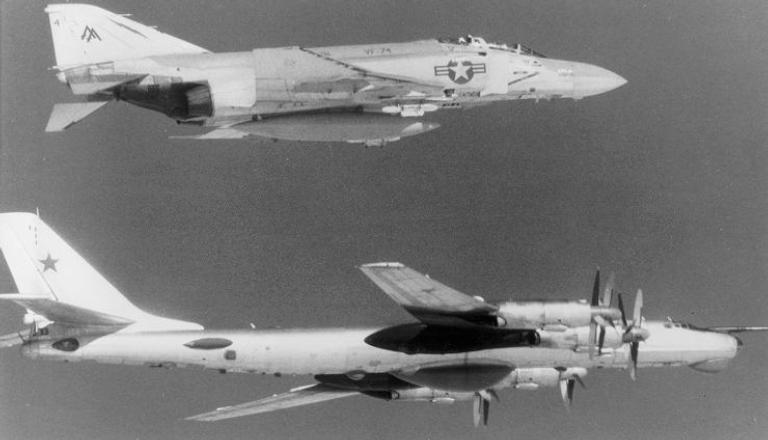
AV-MF Tupolev Tu-95RTs Bear D. The Bear D plays a pivotal role in Soviet maritime strike operations. It relays radar video (imagery) from its large Big Bulge surface search radar via datalink to submarines and surface vessels which use it to target 250nm class Shaddock/Sandbox antiship cruise missiles (US DoD images via FAS).
Editor's Note 2005: Since the fall of the USSR much more technical material has become available on the guidance systems and subtypes of aircraft and submarines employed by the AV-MF and V-MF, superceding some of the technical detail in this work, which was compiled from open sources during the 1980s. The strategic models and doctrine described in this work remain however relevant, since the large scale proliferation of the Russian anti-shipping weapons after 1991 has seen the operational doctrine for using these weapons also exported.
The Western Alliance largely comprises maritime nations and as such depends upon its Sea Lines of Communication (SLOC) for both trade and for power projection. The importance of the shipping lanes to the Western economy cannot be understated, while they also represent the primary means of resupplying NATO and the Far East in the event of any major conflict with the Communist bloc.
It is therefore understandable that the USSR has poured considerable resources into developing a capability to interdict Western SLOCs; the rapid growth in this capability over the last decade is however quite alarming. The Soviets have followed a three pronged strategy of acquiring exceptionally well placed forward bases and of modernising their air and submarine maritime strike force.
Cam Ranh Bay was a valuable prize, offering the ability to cut all lanes to and from Singapore, Taiwan and the Philippines, while forcing much traffic to Japan to take a distinctly Eastern approach. Soviet access to Ethiopia and Aden has similarly provided good coverage to the Indian Ocean approaches to the Suez Canal and Straits of Hormuz. Angola offers only limited coverage of the Cape of Good Hope routes but the potential of South Africa as a target for subversion and eventual domination has worrying implications. The Soviet thrust into Chile during the early seventies is less than coincidental in this context. The Reagan Administration's concern over Central America is not unreasonable given the threat posed to the Panama Canal.
This situation is a direct result of a systematic effort aimed at providing the capability to destroy Allied economic strength through interdiction of its SLOCs; the former CinC of the Voenno Morskii Flot (V-MF = Soviet Navy) Admiral Gorshkov has clearly stated that the interdiction of merchant shipping and its associa ted escorts is the most important constituent part of the efforts of a fleet aimed at undermining the military/economic potential of the enemy.
This philosophy is interesting in that it identifies the primary role of the V-MF as economic warfare with the matter of confronting Western naval forces a secondary issue. Given the capabilities of the US Navy surface fleets this posture maximises the probability of Soviet maritime strike forces surviving a sustained conflict while also maximising the damage inflicted upon the Free World's nett warfighting potential. A sustained SLOC interdiction campaign would ultimately draw Western naval assets away from the areas of direct confrontation, Anti-Submarine Warfare (ASW) and Anti-Air Warfare (AAW) platforms being required to protect the convoys which would be so vital to any major battle on the Eurasian continent.
The systematic upgrading of older but numerically significant weapons platforms in the Soviet Navy and Air Forces underscores the importance of this strategy in the eyes of Soviet leadership; faced with an Allied Carrier Battle Group (CBG) only the newer systems in the Soviet inventory would offer a reasonable probability of inflicting significant damage. The S-3B, P-3C Update IV, SV-22 and Lamps III are a serious threat to any submarine even at extended ranges while the E-2C EA-6B, F-14A/D and F/A-18A/C supported by vertical launch (multishot) SAM firing CG-47 AAW cruisers and DD-963 destroyers would take the bite out of any air strike. In the face of these capabilities, whether concentrated in CBGs or convoys the Soviets have made a major commitment to antishipping missiles, air surface and submarine launched.
Missile firing aircraft and submarines would play an analogous role to the Ju-88s, He-111s, FW-200s, He-177s of the Luftwaffe and U- boats of the Kreigsmarine in WWII.
The Soviet Maritime Strike Forces.
The burden of interdicting Western SLOCs would fall upon three major commands of the Soviet Armed Forces, the V-MF's Aviatsia Voenno-Morskovo Flota (AV-MF = Fleet Air Arm), attack submarine forces of the various fleets, and the Strategic Aviation Forces of the Voenno-Vozdushnye Sily (V-VS = Soviet Air Force). V-MF assets are dedicated to the maritime role, while many V-VS assets would be made available subject to the strategic or tactical situation in the theatre. The USSR has divi ded its naval forces into five fleets, the Northern, Baltic, Black Sea, Caspian (Flotilla) and Pacific Fleets by designation and basing. The key commands in any major conflict would be the Northern and Pacific Fleets, both of which are strategically located and least vulnerable to blockading.
Of particular interest to the Australian observer is the Pacific Fleet, which is home based in Vladivostok and has forward deployment bases at Cam Ranh Bay and access to sites in North Korea and North Vietnam. Cam Ranh Bay is now a major naval and air base with Echo 2 SSGNs (Submarine, Guided missile Nuclear powered) and Bear (8D/F) and Badger (10 C/G and 6 D/F) aircraft permanently deployed. In numerical terms the resources available to the Soviet maritime strike planner are considerable. In submarines, the V-MF can deploy 46 nuclear powered cruise missile firing boats (SSGN), 15 conventional cruise missile boats (SSG), 69 torpedo armed nuclear powered boats (SSN) and 138 conventional boats (SS). Roughly half the SSG and SSGN fleet is deployed in the Pacific.
The AV-MF has approximately 400 strike aircraft, supported by 75 tankers and 100 recce and electronic intelligence/warfare aircraft. Of these 240 are missile firing Badger C/G, 35 Blinder and 125 very potent Backfire B (30 in the Far East). Targeting support is provided by 45 Bear D, 35 Badger D/E/F, with jamming support provided by Badger H/J.
V-VS assets available would include a slice of a 285 strong Badger force, almost all of the Bear G strike force (50 or more) and fractions of the 135 strong Blinder A/B and 140 strong Backfire B forces respectively.
In terms of unrefuelled strike radius, the Bears have the longest reach at 4,500nm, with the Backfire reaching to 2,200nm and the Badgers and Blinders to 1,500nm. All of these aircraft are capable of inflight refuelling from Badger or Bison tankers using probe/drogue or wingtip techniques.
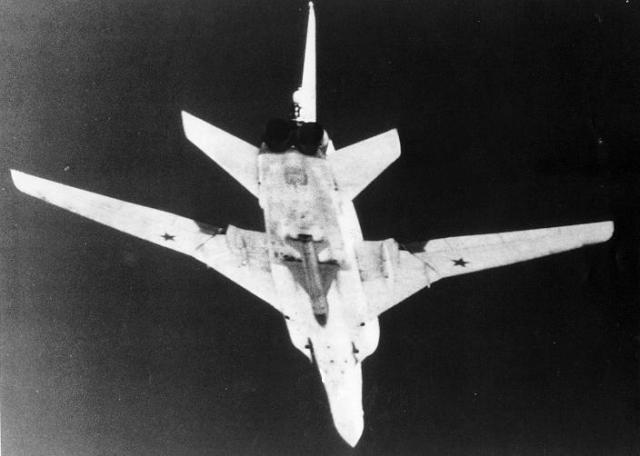
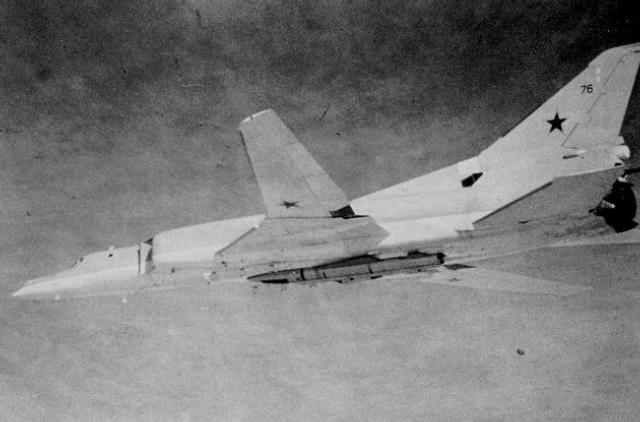
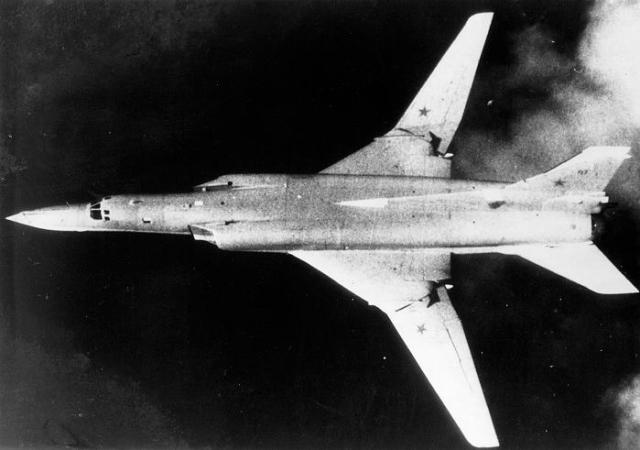
AV-MF/Tupolev Tu-22M Backfire B. The swing wing Backfire is the Soviet answer to the B-1, possessing similar low level penetration performance albeit at shorter ranges. Armed with the potent Mach 3 Kitchen missile, it is the only aircraft in the Russian inventory which can confidently expect to survive an encounter with a USN Carrier Battle Group.
While the strike aircraft can fire a wide range of missile types, the submarines (and surface vessels) are limited to two families of missile.
Soviet Air Launched Antishipping Missiles.
No doubt impressed by the performance of the Luftwaffe's Hs-293 antiship glidebomb, the Russians deployed the rather crude AS-1 Kennel on early Badger B during the fifties. This weapon was carried in pairs underwing and set a trend followed to this day. The drag penalties of this form of carriage were apparent and another approach was adopted for many subsequent weapons; semi-recessed carriage under the fuselage.
The early sixties saw the deployment of two new ASM (Air-Surface Missile) types and specialised launch aircraft to carry them, both primarily dedicated to the antishipping role. These were the duckbill nosed Badger C with its AS-2 Kipper turbojet ASM and the similarly adorned Bear B/C with its massive AS-3 Kangaroo ASM (see AA Nov 1987).
Both launch aircraft carried large and powerful attack radars, the Badger fitted with the I-band Puff Ball and the Bear with the I-Band Crown Drum, both also used datalinks for the midcourse guidance of their missiles, both of which would transition to autopilot guidance and, in the former case, active radar terminal homing for the final dive at the target.
The Badger C and Bear B/C were tasked with striking at Western CBGs; their numerical strength would not have had a major impact in a SLOC interdiction campaign. However both aircraft types were eventually built in large numbers and today represent (as detailed above) the bulk of the dedicated antishipping force with newer types taking on the counter-CBG role.
One of these was the supersonic Blinder B also first seen in 1961. While the Blinder has had an unspectacular career, it offers comparable radius performance to the Badger with respectable Mach 1.4 dash speed. The Blinder was however significant in that it carried the M3.0/250nm class Kitchen ASM.
The Kitchen is to this date a mainstay of the AV-MF and VVS, deployed on Backfire, Bear and Blinder. The AS-4 Kitchen typifies Soviet standoff ASM design and has served as a pattern for the newer AS-6 Kingfish and possibly the reported AS-11.
The Blinder/Kitchen was the pinnacle of Soviet strategic bomber/missile design in the sixties and directly developed into the very potent Backfire/Kitchen system of the early seventies. The Backfire grew out of the Tu-28 Fiddler and Tu-22 Blinder designs, adopting airframe features from the former and systems from the latter with a variable geometry wing. Deployed in the seventies, the supersonic Backfire is the only Soviet aircraft with the performance/electronic warfare capability to threaten a CBG.
While the Backfire developed, the existing Badger force was equipped with a new missile, the transonic AS-5 Kelt. While this weapon was not spectacular it was smaller than the Kitchen and therefore well suited to underwing carriage. A large fraction of the Badger G force carries this weapon to this day.
The performance limitations of the Kelt were apparent and it is now being supplanted with a newer missile, the late seventies AS-6 Kingfish. The Kingfish is much like a smaller and lighter Kitchen and provides a respectable high speed capability to penetrate a SAM umbrella.
Mission Profile
Given the diversity of aircraft and missile types in the Soviet inventory and the range of possible targets, it would be unreasonable to classify any particular profile as typical although there are some common factors.
While prelaunch targeting is done by the launch aircraft using its attack radar and ESM (Electronic Support Measures) where fitted, target detection and tracking over blue water at extended ranges requires powerful surface search radars. These are carried only by several types, in particular the electronic recce Bear D (an in-depth profile of the Tupolev Bear appeared in our Nov 87 issue) and Badger D (also C) of the AV-MF. The Bear D has a known datalink capability and the Badger D has a chin, radome of a shape most unusual for a radar, suggesting its usage for a directional datalink antenna (although a direction finding ESM system such as the AN/ASD-5 could be fitted) [ Editor's Note 2005: the radome is for a datalink antenna].
The recce platform, using data from intelligence or satellite sources, would sweep an area using both its ESM and radar preferring the former for its stealthiness. Subject to the situation a target would be shadowed until strike aircraft would arrive and attack. The attack profile is target dependent, with merchant shipping being hit with ASMs such as Kelt and naval targets being hit with higher performance missiles such as Kitchen and Kingfish. Undefended merchant vessels would be attacked from cruise altitude, Badgers and Bears standing off from outside the range of any deck mounted point defence weapons. Naval vessels with area defence SAMs constitute more of a problem and in isolation would be attacked with several rounds to ensure saturation of the vessel's fire control system. The 2,000 lb class warheads ensure a high probability of disabling on a near miss (Exocet has a 360lb warhead). A typical strike force hunting shipping without air cover would be comprised of Badger D missile firing Badger C/G with tanker support, at extended ranges Bear D and missile firing Bear G again with tanker support.
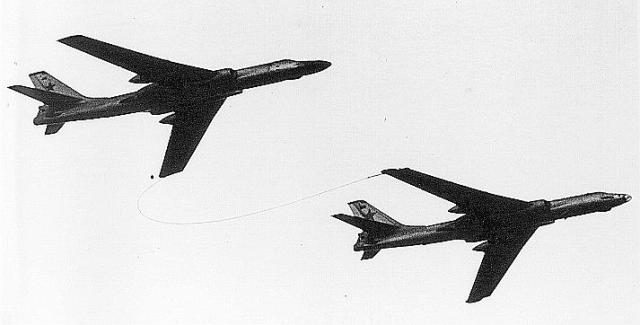
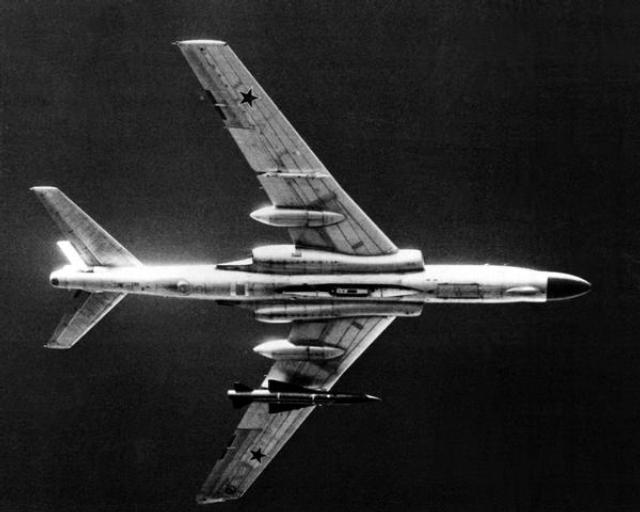
(above and below) AV-MF/Tupolev Tu-16 Badger. The Badger is a mainstay of Soviet Naval Aviation, used for recce, targeting, Elint and in large numbers for anti-shipping strike. The duckbill nosed C, modified C and D versions carry a powerful I-band surface search radar. The two Badgers at top are air refuelling while the bottom aircraft is equipped with a single Kingfish ASM beneath its port wing.
Tackling a CBG with its E-2C AEW umbrella is a more demanding task which is assigned to the Backfire. The attack profile is accordingly more elaborate. Backfires would attack enmasse in order to saturate the air defence system with real and false (decoys and deception jamming) missiles while supporting the attack with communications and radar noise jamming. The run-in to the missile release point would be at a low level, to delay detection to the very last instant, with its radar in standby mode.
The Backfire's Defensive Systems Operator would carefully watch his ESM to ensure the aircraft is well below the radar horizon of the E-2C. Once detected by the E-2C the Backfire pilot would light his burners and pull up into a steep maximum rate climb which would be maintained until up to 30,OOOft or so; this is necessary to provide radar line of sight over the horizon to the CBG. The Backfire's I-band Down Beat radar would be activated only for the several sweeps necessary to lock up a target, any more would provide an EA-6B with an opportunity to jam or deceive. At this instant the Backfire is about 200nm from the CBG, and only several minutes have passed since its detection.
Only if the F-14 CAP (Combat Air Patrol) was in a favourably close position would a Phoenix attack be feasible. The Kitchen is then released and the Backfire turns steeply 180 degrees, after which it unloads and accelerates away from the CBG at supersonic speed. This manoeuvre will maximise separation from the CBG, while the F-14 CAP has a Kitchen to stop. The Backfire will jam also during its egress. It would be reasonable to expect a regiment size strike with groups of Backfires coordinating run-ins from widely separated angles to disperse the CAP fighters and confuse the SAM operators.
The Kitchen will enter a shallow dive under its midcourse inertial guidance cruising at about 2.5M on its liquid propellant sustainer. As it approaches its programmed target, it engages its active radar or passive anti-radiation terminal seeker and homes into impact, obliterating its target with its proximity fused 2,OOOlb class warhead. The high aerodynamic performance of the Kitchen demands a high performance SAM or AAM/Fighter to successfully intercept it while its large size allows for considerable ECCM (jam resistance) in its undernose J-band radar seeker, including features such as home-on-jam (situating the seeker under the nose reduces frontal radar cross-section).

Tu-95KD Bear B

Tu-95K-22 Bear G
Saturation attacks with multiple Kitchens would certainly put the USN's SAM systems to the test. A large coordinated strike against a CBG would almost certainly involve EW (Electronic Warfare) aircraft. The Soviets designate EW as REB (Radio Elektronnaya Borba), using the term REP (Radio Elektronnye Pomekhi) to designate ECM (countermeasures) although abbreviated 'pomekhi' is oft used in literature.
Two EW types used in the AV-MF/V-VS inventory are the Badger H which is a chaff bomber with a likely additional Support Jamming (SJ) role, and the dedicated BadgerJ Support Jammer.
Badger J carries a large ventral canoe radome which almost certainly houses stabilised jamming transmitter antennas much like that of the USAF EF-111A.
Both of these types would stand off from outside the effective radius of the CBG's SAMS and F-14/Phoenix, jamming radar and communications to support the incoming Backfires and later the launched Kitchens. In lower threat environments these types would provide escort jamming for Badger C/G strike formations.
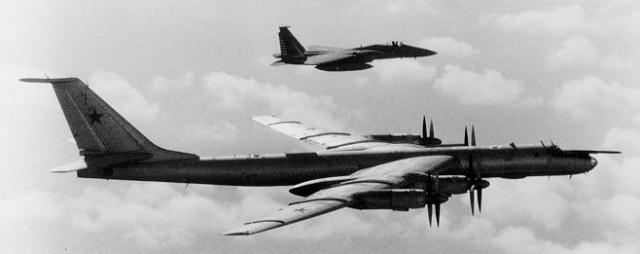
Tu-142 Bear F
While the combined AV-MF/V-VS strike force is formidable, it is to some degree range restricted with most of its aircraft limited to a 1,500nm unrefuelled strike radius in massed strikes. At greater operating radii the SSG/SSGN force comes into play.
Soviet Submarine Launched Antishipping Missiles
The Soviets deployed their first submarine launched cruise missile in 1960, the nuclear SS-N-3c Shaddock was comparable to the USN Regulus missile deployed in 1954. The Shaddock subsequently appeared in two active radar terminal homing antishipping versions, the SS-N-3a sub launched and SS-N-3b ship launched missiles and has together with its derivatives become the V-MF's primary long-range antishipping weapon.
Five SSGNs of the Echo 1 class each carried 6 Shaddocks and formed the embryonic V-MF SSGN force. These boats were followed by the Echo 2 SSGNs and Juliet SSGs, deployed throughout the sixties and gradually tasked with antishipping strike as the newer SSBNs took over the strategic nuclear strike role. Twenty nine of the Echo 2 class were built, each of which carries 8 Shaddock SSMs and displaces cca 6,000 tons. These were supplemented by the conventional Juliets each of which carries 4 Shaddocks and displaces 3,750 tons.

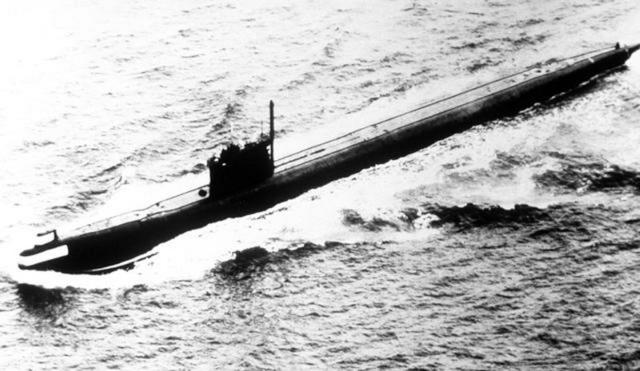
Echo SSGN
The basic limitation of the Echo/Juliet class was the need to surface and raise its launchers in order to fire the Shaddock. The sub therefore had to expose itself and remain exposed during the flight of the Shaddock. This was understandably a dangerous practice when a mere 200nm from a CBG, therefore a missile and sub class were developed to allow underwater launching of SSMs using passive sonar targeting.
The 4,900 ton Charlie 1 SSGN was deployed in the late sixties and 11 were built. The 0.9M/35nm class SS-N-7 was carried, this weapon possessing inertial midcourse and active radar terminal guidance. The Charlie 1 was soon followed by the slightly larger Charlie 2 also equipped with 8 SSMs however of a newer type, the SS-N-9 Siren. Supersonic equipped with alternate active radar or infra-red terminal seekers, the 70nm class Siren was a major improvement upon the SS-N-7 but even so failed to provide the range required to avoid the SSNs and ASW platforms of the USN. A mere seven Charlie 2 SSGNs were built through the seventies.
SOVIET MARITIME STRIKE AIRCRAFT
| | | | | | | | | | | | -------------------- | --------------- | ------------- | ---------------- | --------------- | --------------- | ------------- | ------------- | ----------------- | | NATO Designation | Badger C, Cmod | Badger D | Badger G, Gmod | Badger H/J | Bear D | Bear G | Blinder B/C | Backfire B/C | | Soviet Designation | Tu-16 | Tu-16 | Tu-16 | Tu-16 | Tu-95 | Tu-95 | Tu-22 | Tu-22M2/3 | | | | | | | | | | | | | Primary | Maritime | Maritime | Maritime | H:Chaff Bomber | Maritime | Maritime | B:Maritime | Maritime | | Mission | Strike | Surveillance/ | Strike | J:Support | Surveillance/ | Strike | Strike | Strike | | | | Targeting | Jammer | Targeting | C:Recce/Elint | | | | | | | | | | | | | | | | | Secondary | Maritime | Elint | Land Strike | Elint | Elint | Strategic | B:Land | Strategic | | Mission | Recce | | | | | Strike | Strike | Strike | | | | | | | | | | | | | Dimensions (ft) | | | | | | | | | | | | | | | | | | | | | Span | 108 | 108 | 108 | 108 | 167.75 | 167.75 | 78 | 113/78.75 | | Length | 120 | 120 | 114.2 | 114.2 | 155.8 | 155.8 | 133 | 140 | | Height | 35.5 | 35.5 | 35.5 | 35.5 | 39.75 | 39.75 | 35 | 34.5 | | | | | | | | | | | | | Weights [lb] | | | | | | | | | | | | | | | | | | | | | Empty | approx 82,000 | ~ 82,000 | ~ 82,000 | ~ 82,000 | ~ 165,000 | ~ 165,000 | 90,000 | 119,000 | | Gross T/0 | 158,500 | 158,500 | 158,500 | 158,500 | approx 330,000 | ~ 330,000 | 185,000 | 287,000 | | Internal Fuel | 78,000 | 78,000 | 78,000 | 78,000 | approx 130,000 | ~ 130,000 | 80,000 | 126,000 | | | | | | | | | | | | | Propulsion ‘ | | | | | | | | | | | | | | | | | | | | | Type | 2xAM-3M TJ | 2xAM-3M TJ | 2xAM-3M TJ | 2xAM-3M TJ | 4xNK-12MV TP | 4xNK-12MV TP | 2xVD-7 TJ AB | 2xNK-144 der.TFAB | | Thrust/SHP (lb) | 20,950 | 20,950 | 20,950 | 20,950 | 14,795 (SHP) | 14,795 (SHP) | 30,900 | 48,500 | | | | | | | | | | | | | Offensive Systems | | | | | | | | | | | | | | | | | | | | | Attack Radar | C:Puff Ball (I) | Puff Ball (I) | G:Short Horn (J) | none | Big Bulge (I/J) | Down Beat (?) | Down Beat (1) | Down Beat (1) | | | Cmod: | | Gmod: ? | | | Crown Drum (I) | | | | | | Down Beat (?) | | | | | | | | | | Nav Radar | Short Horn (J) | none | none | Short Horn (J) | Mushroom (I) | possibly | none | none | | ESM | probably | yes | possibly | yes | yes | yes | yes | yes | | Datalink | probably | yes | probably | probably | A-364Z Video | yes | probably | probably | | Other | | | | J:Jammers (A-1) | | | | | | | | | | H:Chaff Dispn | | | | | | | Weapon Load | C:1xKipper | none | G:2xKelt | none | none | 2xKitchen | 8:1xKitchen | 1(2,3)xKitchen | | | Cmod: | Gmod:1xKingfish | Bombs | Bombs, Mines | Bombs, Mines | | | | | | | 2xKelt | | | | | | C:none | | | | | 1xKingfish | | | | | | | | | | | | | | | | | | | | | Defensive Systems | | | | | | | | | | | | | | | | | | | | | RWR/RHAW | Sirena 2/3 | Sirena 2/3 | Sirena 2/3 | Sirena 2/3 | Sirena 3 | Sirena 3 | Sirena 2/3 | Sirena 3 | | Tail Warning/ | Bee Hind | Bee Hind | Bee Hind | Bee Hind | Box Tail | none | Bee Hind | Fan Tail | | Fire Cntrl Radar | | | | | | | | | | Guns | 6xNR-23 | 6xNR-23 | 6xNR-23 | 6xNR-23 | 4(2)xNR-23 | 2xNR-23 | 1xNR-23 | 2xNR-23 | | ECM | yes | yes | yes | yes | yes | yes, pods | yes | yes | | IFF | SRO-2 | SRO-2 | SRO-2 | SRO-2 | SRO-2 | SRO-2 | SRO-2 | SRO-2 | | | | | | | | | | | | | Performance | | | | | | | | | | | | | | | | | | | | | Max Speed, Alt(kt) | 535 | 535 | 535 | 535 | 500 | 500 | 800 | 1100 | | Max Speed SL (kt) | 500 | 500 | 500 | 500 | - | - | 500 | 594 | | Cruise Speed Alt(kt) | 460 | 460 | 460 | 460 | 405 | 405 | 490 | 490 | | Combat Radius (nm) | 1,565 | 1,565 | 1,565 | 1,565 | 4,475 | 4,475 | 1,565 | 2,160 | | | | | | | | | | | | | | | | | | | | | |
| Table 1: | ABBREVIATIONS: TJ-Turbojet, TP-Turboprop, TF-Turbofan, AB-Afterburning, SHP-Shaft Horsepower Attack, Nav Radars designated bands eg (I/J) to US DoD band designations. ESM-Electronic Support Measures, TFR-Terrain Following Radar, RWR-Radar Warning Receiver, RHAW-Radar Homing And Warning, ECM-Electronic Counter Measures, IFF-Identification Friend Foe. The ’Cmod, Gmod’ is an abbreviation for ’modified C, modified G’. This table was compiled from a wide range of sources and items such as performance, equipment fit and weights should be treated with caution. In particular radar seems to be a source of much confusion. Recent information suggests that the Bear D/E/F carries the Mushroom rather than Puff Ball (refer p 104 Nov 87 AA) the Bear F the Wet Eye in place of the Big Bulge (although this may vary between airframes) while the ventral radome on Badger Gmod remains unidentified. |
|---|
The V-MF continued to experiment and during the seventies tested a large and fast SSGN of the Papa class, equipped with 10 Siren SSMs. This development led to the early eighties deployment of the massive 14,500 ton 35kt Oscar class SSGN armed with 24 SSMs, reported to be advanced SS-N-19s. The SS-N-19 has been described as a derivative of the Shaddock/Sandbox family offering supersonic 300nm range and active radar or infrared terminal homing, with the punch of a larger warhead than the lightweight Siren family.
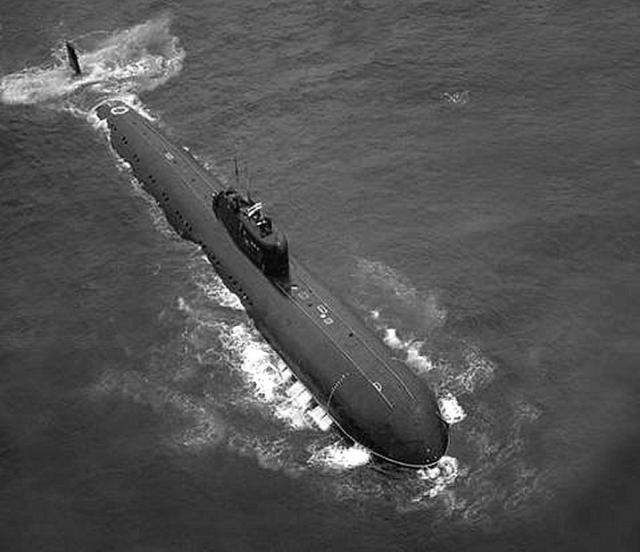
The Oscar would employ passive sonar targeting or raise a boom with a satcom or other antenna to receive targeting information from aircraft or satellites, while submerged. The SS-N-19s are then fired submerged and use inertial midcourse guidance.
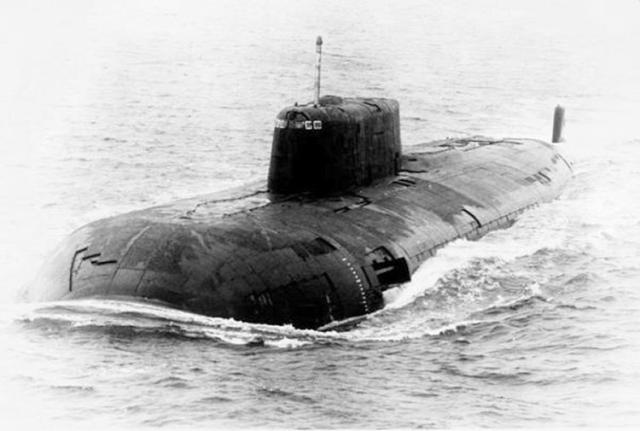
While the Oscar has the capability to launch a massive SSM strike, it is a large and lucrative target for any Allied SSN and would therefore be at considerable risk. To date only three of these boats have been built. The apparent slowdown in the deployment of SSGNs seems to, if anything, suggest a recognition of their limited capabilities in the ASW platform rich environment surrounding a CBG. The current retrofitting of the Echo 2 class SSGNs to carry the newer SS-N-12 Sandbox SSM in place of its Shaddocks suggest a major to the SLOC interdiction role. The Sandbox is a supersonic weapon comparable to the Shaddock but with slightly greater range and presumably a better terminal seeker, it is deployed on heavy cruisers.
Mission Profile
The Echo 2/Juliet class with their associated Shaddock/Sandbox SSMs are the numerically most significant SSGN/SSGs in the V-MF inventory while the Shaddock/Sandbox is the primary long range SSM of the Soviet surface fleet. An Echo 2/Shaddock strike is therefore fairly representative of Soviet SSGN strike tactics.
A key element in such a strike is the large Tu-95RTs Bear D maritime recce aircraft, which will use its extensive range of ESM systems to locate likely surface targets. Once these are found the Bear will shadow the target until the SSGN has moved into a suitable position to attack.
The Echo will then surface and turn to a heading toward the target. A deck crew (presumably) will assist with the opening of the boat's fin, the forward part of which is hinged and swings open by 180 degrees to expose the Front Door and Front Piece F-band midcourse guidance radar antennas. At this stage the large missile launchers, stowed horizontally and flush with the upper deck, are raised. These pivot at the aft end, where blast defecting indentations in the hull carry the flux of booster exhaust away from the boat (the arrangement is not unlike the Transporter Erector Launcher used with the USAF Ground Launched Cruise Missile). The Shaddock/Sandbox is then ready for launch.
SOVIET ANTISHIPPING MISSILES
| | | | | | | | | | | | --------------- | -------------- | --------------- | --------------- | ------------ | ------------- | -------------- | ------------- | ------------- | | NATO | AS-4/Kitchen | AS-5/Kelt | AS-6/Kingfish | SS-N-3/ | SS-N-7/Siren | SS-N-9/(Siren) | SS-N-12/ | SS-N-19/ | | Designation | | | | Shaddock | | | Sandbox | | | | | | | | | | | | | | Soviet | | | | | | | | | | Designation | Burya | - | - | P-6, P-35 | - | - | - | - | | | | | | | | | | | | | Primary | | | | | | | | | | Role | Antiship ASM | Antiship ASM | Antiship ASM | Antiship SSM | Antiship SSM | Antiship SSM | Antiship SSM | Antiship SSM | | | | | | | | | | | | | Launch | Blinder B (1) | Badger G (2) | Badger Gmod (1) | Echo 2 (8) | Charlie 1 (8) | Charlie 2 (8) | Echo 2 (8) | Oscar(24) | | Platforms | Backfire B (1) | Badger C (2) | Badger C (1) | Juliet (4) | | | Juliet (4) | | | | Bear G (2) | | | | | | | | | | | | | Badger Cmod (1) | | | | | | | | | | | | | | | | | | | Dimensions (ft) | | | | | | | | | | | | | | | | | | | | | Span | 9.8 | 14.1 | 8.2 | ~ 6.9 | - | - | ~ 8.5 | - | | Length | 37.0 | 28.2 | 34.5 | ~ 33.5 | 23.0 | 29.0 | ~ 38.5 | ~ 38.5 | | | | | | | | | | | | | Weight (lb) | 13,225 | 7,715 | 11,000 | ~ 9,900 | ~ 7,700 | ~ 6,600 | ~ 11,000 | - | | | | | | | | | | | | | Warhead (lb) | 2,200 HE | 2,200 HE | 2,200 HE | 2,200 HE | 1,100 HE | 1,100 HE | 2,200 HE | 2,200 HE | | | nuclear | | nuclear | nuclear | nuclear | nuclear | nuclear | nuclear | | | | | | | | | | | | | | Propulsion | Liquid Rocket | Liquid Rocket | Liquid Rocket | Turbojet | Solid Rocket | Solid Rocket | Turbojet | Turbojet | | | | | Boost Rocket | | | Boost Rocket | Boost Rocket | | | | | | | | | | | | | | | Midcourse | Inertial | Autopilot | Inertial | Command Link | Inertial | Inertial | Command Link | Inertial | | Guidance | | | | | | | (/Inertial ?) | | | | | | | | | | | | | | Terminal | Active Radar | Active Radar | Active Radar | Active Radar | Active Radar | Active Radar | Active Radar | Active Radar | | Guidance | Antiradiation | Antiradiation | Antiradiation | | | Infra-red | | Infra-red | | | | | | | | | | | | | Targeting | Launch A/C | Launch A/C | Launch A/C | Bear D | Launch Vessel | Launch Vessel | Bear D | Launch Vessel | | Platform | | Badger D | Badger D | Hormone B | | | Hormone B | Bear D (?) | | | | | | | | | | | | | Performance | | | | | | | | | | Max Speed | 3.0M+ | transonic | 3.0M+ | transonic | transonic | transonic | ~ 2.5M | ~2.5M | | Range (nm) | ~ 200 (Lo) | ~ 100 | ~ 135 (Lo) | ~ 250 | ~ 35 | ~ 70 | ~ 300 | ~ 300 | | | | | | | | | | | | | | | | | | | | | |
| Table 2: | All range and performance figures must be treated with caution, as many sources disagree over various parameters. The SS-N-3b is carried by the Kresta (4) and Kynda (8) PKRs (eq CG) supported by Scoop Pair radar, the SS-N-9 is carried by the Kiev (8) TAKR (STOVL Carrier) and Slava (16) RKR (eq CG) supported by Front series radar and the SS-N-9 by the Kirov (20) RKR (Battle Cruiser ICGN) in vertical launch tubes, targeted by Hormone 8 or Helix B helicopters. |
|---|
The Bear will then approach the radar line of sight to the target, cca 200nm, and turn on its powerful I/J-band Big Bulge surface search radar. Radar video from the Big Bulge is then transmitted via an A-364Z J-band datalink to the combat information centre of the Echo, where it presumably appears on a radar scope. Once a target is selected, a Shaddock is launched. The missile will initially climb on a rocket booster until sufficient speed is attained to start up a turbojet cruise powerplant. At this point the missile is presumably flying on autopilot and the Front Door/Front Piece is activated to track it.
Front Door is a nodding height finder, above which the small azimuth tracking Front Piece is mounted. It is likely that the Shaddock carries an F-band transponder to minimise the required radar transmit power while avoiding scintillation. A datalink is then used to steer the Shaddock on to a desired heading, based on available missile and target track information. The Shaddock will steeply climb to an efficient cruise altitude and head toward the target on autopilot, with updates via datalink. Cruise altitudes of about 20,000 ft have been quoted although this would limit the duration of flight during which the Shaddock is above the Echo's radar horizon; higher altitudes may be used at longer ranges.
The large Front Door antenna implies the need for accurate height information at extended ranges which supports this view. Once the Shaddock has been flown within several miles of the target, its active radar terminal seeker is engaged and the Shad dock dives into its target. It is unclear from available literature whether the Shaddock remains under the sub's control until seeker engagement or whether there is a phase of flight under autopilot alone or autopilot with updates from the Bear's Big Bulge. All are reasonable and may in fact be version specific options.
It is however reasonably certain that the fully (sub) controlled flightpath has been used as Echo's, and have been known to remain on the surface for up to 25 minutes after a Shaddock launch.
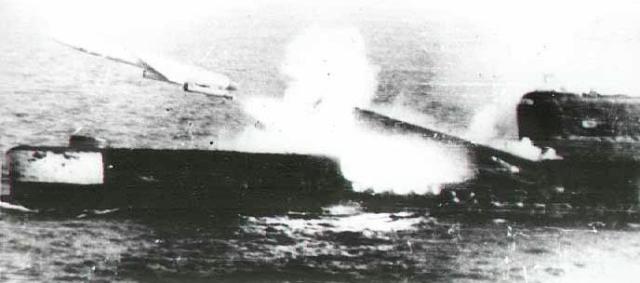
Shaddock launch.
Given the inevitable improvements in Soviet inertial technology, it is very likely that later missiles such as the Sandbox and SS-N-19 do in fact have sufficiently accurate onboard references to avoid the need for full midcourse tracking guidance.
The targeting and midcourse guidance technique used for the Shaddock is not viable in a high threat environment as the Bear and SSGN cannot engage in evasive manoeuvring without risking the loss of the Shaddock. Furthermore the datalinks can be detected by the opponent's ESM and may well be jammed. Both the Bear and the SSGN are broadcasting their position and intent via the use of the Big Bulge and Front series radars and will attract tactical aircraft.
Given the V-MF's commitment to upgrading its 20 year old Echo 2/Juliet SSGN/SSG force with new missiles and electronics, one cannot draw any other conclusion than that of these assets being assigned to SLOC interdiction.
The Soviet maritime strike force has often been denigrated by observers who correctly identify the limited capability of much of their inventory in the face of a modern Western Carrier Battle Group. This is, however, an incorrect judgement as the primary role of this force is the interdiction of Western shipping lanes for which it is well equipped. Access to strategically situated air and naval bases provides the USSR with the option of inflicting considerable damage upon Western economies in the event of any confrontation. This could be achieved without unreasonable attrition of aircraft or submarines and would require a disproportionate defensive response to prevent.
Disbelievers are advised to review the activities of Kampfgeschwaders 40, 100 and of course the Kriegsmarine during the 1940-45 period.
References
- Taylor JWR, Mason RA, AVM, Soviet Air Force, Jane's 1986.
- Polmar N, Soviet Weapons and Electronics, International Countermeasures Handbook, 12th Ed, EW Communications, 1987.
- Update Program Continues for Echo II, Jane's Defence Weekly, 19 April, 1986.